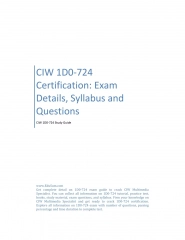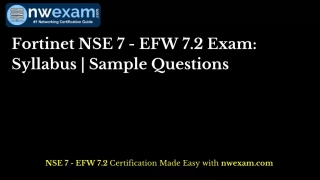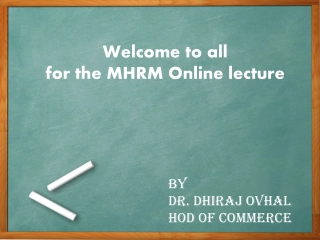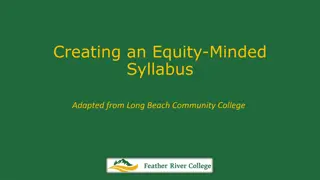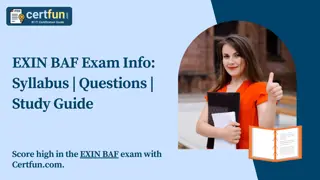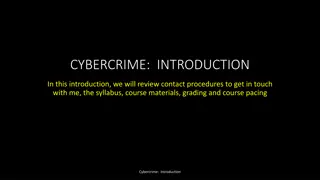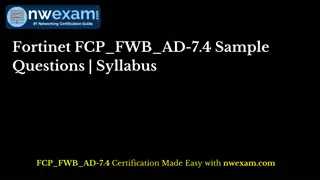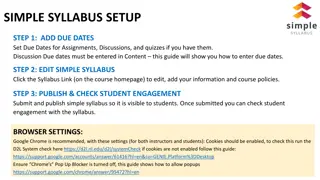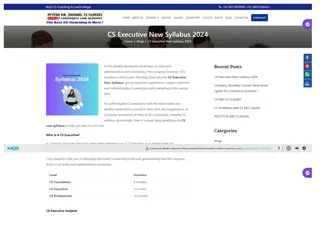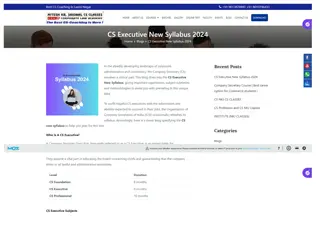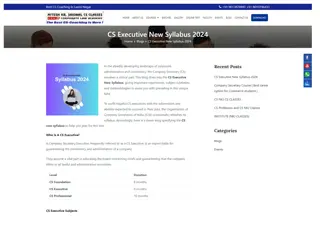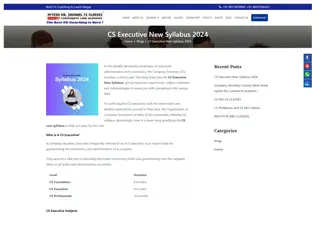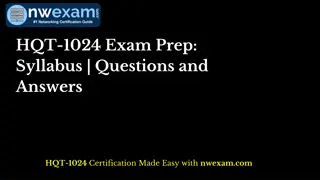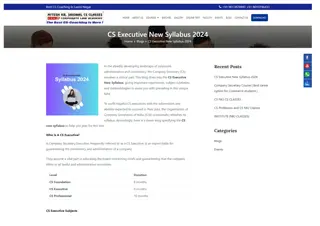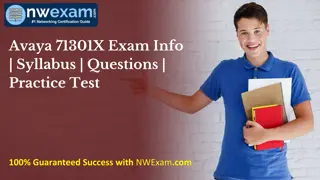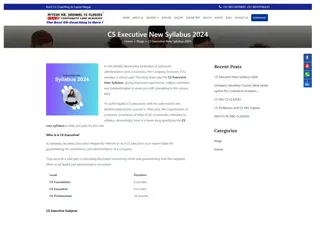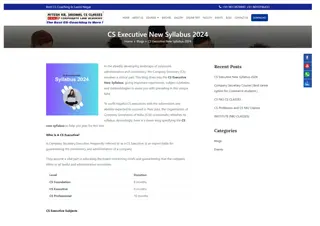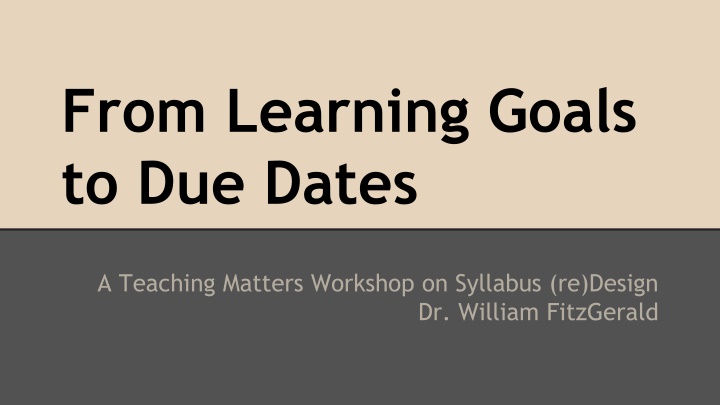
Effective Syllabus Design Strategies for Teaching Success
Explore the key components of syllabus (re)design, including learning goals, modes of instruction, assessment methods, and student-centered approaches. Enhance your teaching effectiveness with practical guidance on crafting clear syllabi that align course objectives with student outcomes, supported by examples and tools for effective goal setting and communication.
Download Presentation

Please find below an Image/Link to download the presentation.
The content on the website is provided AS IS for your information and personal use only. It may not be sold, licensed, or shared on other websites without obtaining consent from the author. If you encounter any issues during the download, it is possible that the publisher has removed the file from their server.
You are allowed to download the files provided on this website for personal or commercial use, subject to the condition that they are used lawfully. All files are the property of their respective owners.
The content on the website is provided AS IS for your information and personal use only. It may not be sold, licensed, or shared on other websites without obtaining consent from the author.
E N D
Presentation Transcript
From Learning Goals to Due Dates A Teaching Matters Workshop on Syllabus (re)Design Dr. William FitzGerald
Definition Plan (how you conceive the course) Guide (how you map the course) Contract (what you promise and expect)
Plan - Syllabus as Building Block Learning Goals Modes of Instruction Means of Assessment
Guide - Syllabus as Blueprint The syllabus as Orienting document Nuts and bolts handbook Rhetorical stance
Contract - Syllabus as Handshake Expectations Caveats Mutual accountability
Learning Goals Measurable, Manageable, Meaningful Student-centered Grounded in Continuous Improvement
Learning Goals Three categories: Knowledge Skills Abilities/Attributes
Writing Learning Goals Initial draft: Students will be familiar with the major theories of conflict resolution. Revision: Students will be familiar with withdrawal, smoothing, forcing, compromising, and problem solving. Further revision: Students will summarize the concepts of withdrawal, smoothing, forcing, compromising, and problem solving. Specific: Students will summarize the five major approaches to conflict resolution: withdrawal, smoothing, forcing, compromising, and problem solving. Higher order thinking objective: Students will choose and defend a conflict resolution approach appropriate for a given situation. Source: University of Oregon Teaching Effectiveness Program
Example: Biochemistry and Molecular Biology at Wooster Upon completion of the major, we intend that a BCMB student will... 1. Possess a broad and fundamental understanding of biology and chemistry with particular focus on how molecules found in biological systems confer the properties of living organisms. 2. Be able to perform the common methods and use the tools of the field including laboratory and computational techniques. 3. Have the ability to conduct independent scientific investigation and scientific inquiry. 4. Be able to locate, evaluate, and communicate scientific information effectively both by written and oral presentation.
Example: Economics at Bucknell Majors in Economics will be able to: Identify and analyze mainstream and heterodox economic concepts, theories and tools. Summarize, explain, and critically analyze economic arguments orally and in writing. Locate and interpret economic data. Locate, interpret and assess sources of economic information. Develop skills and knowledge that provide a foundation for pursuing lifelong learning and a socially responsible life.
Example: History of Art at Middlebury Students in the major will, by inquiring into the modes and meanings of visual arts and culture: develop their abilities as critical thinkers by questioning works of art and architecture and developing arguments about the circumstances of their production and meaning learn to build extended arguments based upon composite evidence: visual, historical, and textual engage creative research problems that, over time, yield new insights into art, architecture, history and culture become strong, convincing writers through using a variety of approaches to write about the history of the arts, architecture, and visual culture become highly skilled at presenting their work through oral, public presentations
Assignments Meaningful Connected to learning goals Clear
Mapping Learning Goals to Assignments Three examples from The Chronicle of Higher Ed
Syllabus Checklist Course overview: Teaching approaches / activities Learning goals How does the course fit within the program of study? How do the course goals support the program goals? How do the course goals align with the general education goals? (adapted from U. Delaware)
Syllabus Examples Online syllabus From Danielle Devoss Syllabus design notes and examples from BYU
Readings Note Example Guide to the Readings Course: Eastern European History: 1918 to Present I want to take a moment to clarify how I hope you will approach the readings. First, don't take the readings as gospel. Just because something is printed does not make it Absolute Truth. Be critical of what you are reading, drawing upon your own experiences and other knowledge. I have chosen many readings precisely because they are provocative. If you find yourself strongly disagreeing with a particular reading, that's fine; indeed, I encourage strong disagreement. However, if you disagree, you must clarify in your mind the reasons and evidence upon which you are basing your disagreement. At the same time, keep an open mind. Listen to what the readings have to say. Think about what experiences you may have had and reading you have done that may corroborate the course readings. Give yourself time to reflect on the information offered in the readings. These are not readings to be run through rapidly. Take your time with them; allow yourself to enter into a kind of conversation with them. (adapted from U. Delaware)
Academic Integrity Example Here are some practices that are acceptable: Getting procedural advice from B&E lab consultants. Discussing ideas about assignments with fellow students. Showing a classmate how to do a computer procedure (or getting help with a procedure in this way). Getting help from your instructor. Here are some practices that are not acceptable: Copying (by whatever means) another student's work or duplicating another student's problem solving steps. This means it is not acceptable to do an assignment by having another student dictate the assignment's keystrokes to you, or to let another student do things for you. Submitting another student's work, in whole or in part, as your own on an assignment or examination. Copying (electronically or by hand) someone else's computer file, modifying it, and handing it in as your own work. Having someone load his/her assignment into the computer, then modifying it and handing it in as your own work. Working with other students in unauthorized ways, in order to complete assignments; e.g., working in a team of 3, when teams of 2 are specified. Allowing another person to copy all or part of your work, to hand in as their own. Thus, you should not provide a paper or electronic copy of your work to a classmate to use as a "reference" in doing their work. And you should not post your work to a web site or to an electronic bulletin board, or similar medium, for reference by others. (adapted from U. Delaware)
Assignment Design I. Initial questions II. Learning Outcomes III. Getting Specific IV. From Assignment to Assignment Sheet
Initial Questions What is the assignment? What are my goals for a particular assignment? Where does this assignment fit within my course, field? What new skills and concepts does this assignment involve? What prior skills and concepts are involved? How do I best communicate what I want for this assignment?
Learning Outcomes What learning goals does this assignment promote? How will these goals be assessed? How will these goals and assessment measures be communicated?
Getting Specific What is the audience and purpose of the assignment? What is the disciplinary character of the assignment? What are the specific tasks of the assignment? What are the stages of the assignment? What are the necessary and available resources for the assignment? What kinds of framing and support are required for this assignment?
From Assignment to Assignment Sheet What do students need to know, and when? How much information is too much? What necessary and useful information must the assignment sheet include? What caveats, models, milestones, formalities and rubrics do you include?

